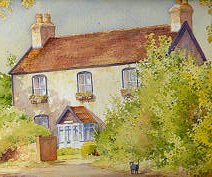|
Weston-super-Mare is known for its flat sandy beach, donkey rides, grand pier, and a tidal range which is one of the largest in the World. When the tide goes out in Weston it goes out a long way. Off the shore are the small islands of Flat Holm and Steep Holm, which is a bird sanctuary, and at the Southern end is the finger of Brean Down where the Mendips meet the sea. This is populated by birds and rabbits as well as walkers on a fine day when there are good views across to Wales.
The site of our house has 'Old Auster' status which means that it is of medieval origin. Originally a farm workers cottage for the nearby Church Farm, it was one of many buildings in the area owned by a Merchant Venturers society from Bristol. The Merchant Venturers were groups of investors who funded sea voyages of adventure during the 1700's from the port of Bristol to find new trading routes to the New Worlds of America, Africa and India. In 1707 the cottage was tenanted to a Richard Manship who paid a rent of 1 shilling per year for one tenement, garden and orchard. It was one of 13 houses that formed the village. An inscription can be seen on Matthew's bedroom window which reads "Cowflipping 1786". Inclosure was granted in 1800, and it was purchased from the Merchant Venturers in 1918. . Around 1900 Miss Glimstead came to live in the cottage. A photo of the 18 pupils at Locking school in 1910 shows two brothers - a Cecil Glimstead and a Jack Glimstead. Their uncle John (Jack) Glimstead was killed on 2 September 1917 at the Battle of Ypres during the 1st World War. There is also a photo of two sisters outside the front door of the cottage dated around the turn of the century. Two nieces remember being evacuated from London to stay at the cottage with their Aunt Min (Mrs Isles) during the 2nd World War when they kept chickens at the bottom of the garden. The village of Locking grew considerably during the 1950's, and the cottage was extensively renovated in the 1960's. Originally called Myrtle Cottage it was renamed The Old Rectory, although its connection with the nearby church is tenuous as there has long also been a Vicarage next to the church. Visiting clergy may have stayed as the cottage was run for a while as a Bed and Breakfast. We have lived here since 1989. |
 We live in Locking which is a village in Somerset, in the SW of
England. It is near Weston-super-Mare which is a seaside town on
the Bristol channel across the Severn Estuary from South Wales.
We live in Locking which is a village in Somerset, in the SW of
England. It is near Weston-super-Mare which is a seaside town on
the Bristol channel across the Severn Estuary from South Wales.  The village of Locking is small but can boast a long history. There
is evidence of Roman settlements nearby. The name "Locking"
has a Saxon derivation probably meaning "Locc's people" and
it was in the Saxon period that the Church and village grew. St Augustine's
church in Locking was founded around 1230 by the monks of Woodspring
Priory. The oldest part of the church visible today is the tower which
was built in 1380. The font has carvings characteristic of celtic art
from the 11th century, and the figures at the corners are dressed in
armour of the style of Richard 1 (1189-1199). Locking Church website
can be found at
The village of Locking is small but can boast a long history. There
is evidence of Roman settlements nearby. The name "Locking"
has a Saxon derivation probably meaning "Locc's people" and
it was in the Saxon period that the Church and village grew. St Augustine's
church in Locking was founded around 1230 by the monks of Woodspring
Priory. The oldest part of the church visible today is the tower which
was built in 1380. The font has carvings characteristic of celtic art
from the 11th century, and the figures at the corners are dressed in
armour of the style of Richard 1 (1189-1199). Locking Church website
can be found at